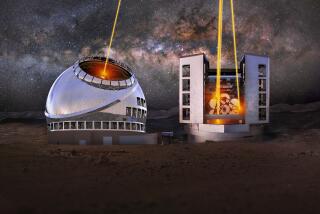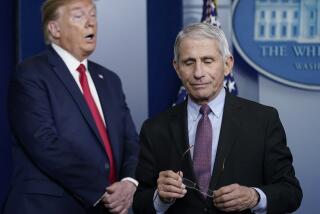Redoing Science Policy : Clinton quietly seeks a new rationale in a key matter
- Share via
It has been largely lost in the hubbub over Haiti and other headline-grabbing issues, but the Clinton Administration has been quietly trying to bring a new rationale to American science policy. Probably no administration since President John F. Kennedy’s has taken such a strong interest in harnessing science and technology to promote national interests and economic competitiveness. But President Clinton has also put top priority on deficit reduction, making it hard to match lofty rhetoric about “vigorous exploration” of scientific frontiers with the dollars to do it.
For more than half a century, U.S. science was driven largely by the imperatives of World War II and the ensuing Cold War. That made science fat and prosperous, but also distorted it.
The Clinton Administration deserves credit for recognizing that. In its first formal science statement, “Science in the National Interest,” Clinton and Vice President Al Gore stressed the connections between basic research and industrial technology. They called for a refocusing of the $73-billion federal research budget toward health, transportation, the information “superhighway,” clean vehicles, global environmental protection and other civilian concerns. And they called for increasing American public and private investment in research and development from 2.6% to 3% of gross domestic product, matching Japan’s.
All worthy goals, but not easily achieved in this fiscal climate. The budget just passed by Congress represents a zero-sum game for science. Some agencies, primarily the National Science Foundation (NSF) and the National Institute of Standards and Technology (NIST), got big boosts. But that means tough times for scientists supported by NASA, the National Institutes of Health, the Defense and Energy departments and other agencies. And there has still not been much progress toward the Administration’s goal of shifting the balance of federal support so that defense and civilian research and development are funded at about equal levels.
Particularly interesting is the NIST, a Commerce Department agency that is Clinton’s main vehicle to provide high-risk research support to promising new industries. This raises the controversial question of whether the government means to set industrial policy for the country.
Given fiscal constraints, a key question is whether Washington can get more bang for the science dollar. To that end, Clinton has created the National Science and Technology Council, an interagency panel meant, in bureaucratic jargon, to “crosscut” the science budget.
In English, that means to reduce redundancies among agencies. Efforts are being made also to save money by inviting international cooperation on major science projects like the space station. The council has seldom met, and it remains to be seen whether it can do much. History suggests such ambitious agendas falter on the bureaucratic inertia of Washington.
Clinton wins high marks for quality appointments, including John H. Gibbons as presidential science adviser, the Nobelist Harold A. Varmus as director at NIH, Neal F. Lane as NSF director and John M. Deutch, former provost at the Massachusetts Institute of Technology, as deputy secretary of defense. And Clinton’s advisers have tackled the scientific disorder at NASA and the need to find a new purpose for the national laboratories run by the Defense and Energy departments now that weapons development is a lower priority.
Half a century ago, a prominent physicist and statesman of science, Vannevar Bush, issued a seminal report, “Science: The Endless Frontier.” That document established firmly that the federal government had a special responsibility to support basic research. That investment gave the United States world preeminence in science and medicine, not to mention military might. But the time has come to devise a new science policy that recognizes a new world reality forced both by the dramatic political changes of the last dozen years and by new communications and other technologies. The Administration has made a start.






